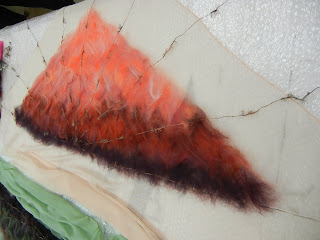These pictures show the scarf after I took it off the loom, and the pleating and tying.
After all the threads were gathered and tied, the scarf was steamed for 30 minutes.
I let it dry, which took forever, and then started removing the supplemental threads. One of the threads had broken when I was knotting the threads and although it didn't look like it would cause a problem, there was a definite flat spot in the scarf. ARGHH
 |
| repair gathers. |
It worked! The flat spot is gone, the scarf is soft and lush. You can't put this scarf in the dryer as you would with a flat chenille scarf or your pleats would relax, so it doesn't have quite the same surface that most chenille scarves have. I am also worried that the tails will worm over time. There was enough warp for two scarves on the loom and the second one is just a plain weave chenille scarf. I twisted the tails 30 times in one direction with 3 strands in each side and they still wormed. I have been told to only use 4 strands total and twist 50 times. Sooooo, I will untie and retwist, again. I have already done it twice and it is still wrong.
















































